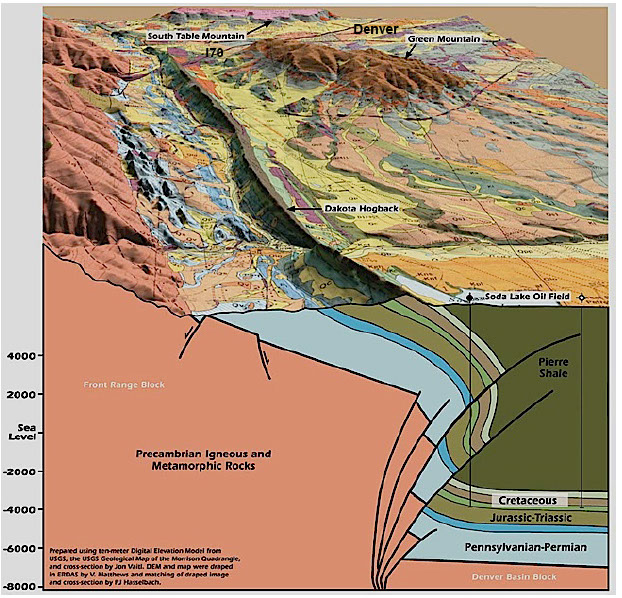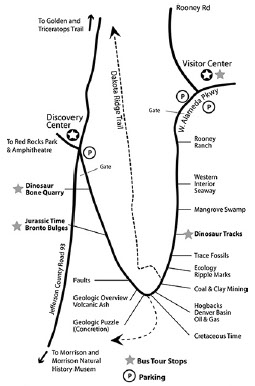WEGA in the North West United States
Return to "Day" page
Return to Day 14 Page
Geological Background
The eastern most margin of the Cordillerra is marked by the Rocky Mountain front ranges which are faulted against the Palaeozoic and Mesozoic rocks forming the high plains on which Denver is situated. The upfaulting of the Proterozoic basement crystalline rocks has produced a spectacular uptilting of the sedimentary cover producing a N-S hogsback with flatirons running N-S in the region of Boulder to Golden.
The area where I 70 runs E-W through the frontal ranges demonstrates some spectacular geology.

The Red Rocks amphitheater shows remnant hogbacks of the Pennsylvanian-Permian Fountain Formation (dark red, arkosic conglomerates, sandstones, and shales) and its contact with the Precambrian crystalline basement rocks. The panoramic view of the Denver area, provide a dramatic backdrop for the stage. Built by 200 men from the Civilian Conservation Corps and opened in 1941, the amphitheater is visited by 750,000 people per year, including 350,000 who attend concerts.
Dinosaur ridge is a section of the Cretaceous Dakota sst that has been turned into a interpretive centre because of the large number of dinosaur finds. Some of the best-known dinosaurs were first discovered here in 1877, including Apatosaurus, Diplodocus, Allosaurus, and Stegosaurus, the Colorado State Fossil.
I-70 roadcut exposes the Jurassic Morrison Formation to the west, which here is composed of fluvial shales and siltstones, overlain to the east by Cretaceous sandstones, the most noteable of which is the Dakota sst.
Triceratops Trail winds between large, vertical walls of sandstone and into reclaimed clay pits, that are of the Upper Cretaceous Laramie and Araphoe Formations (~ 68Ma), representing a tropical swampy, deltaic environment. There are several stops highlighting clay mining and dinosaur, bird, mammal, insect, and invertebrate tracks and traces, as well as several walls full of plant impressions from the tree-lined deltaDinosaur Ridge-like environment. Footprints of at least four different types of dinosaurs - possible Tyrannosaurus Rex, possible Edmontosaurus, and Triceratops, two types of birds, a mammal, and a beetle occur on the sandstone walls. Many of these tracks, when discovered, were first such examples – those from the Triceratops, the mammal, and the beetle. The footprints here differ from those at Dinosaur Ridge. The Dinosaur Ridge tracks are roughly 100 million years old, and are positive tracks – as in where the animal pushed into the sediment. Triceratops Trail features tracks that are around 68 million years old and are negative tracks, i.e. viewed from the bottom, formed when the animal stepped in the mud, which was then filled with sand, forming a natural cast, and then tilted vertical by the uplift of the Rocky Mountains.
Return to Day 14 Page
May 29th to June 11th 2016
